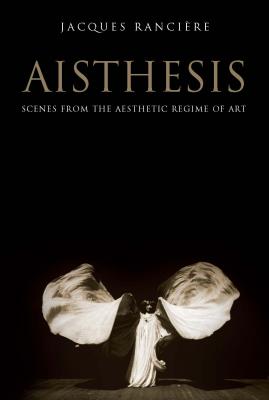ТОП просматриваемых книг сайта:
Aisthesis. Jacques Ranciere
Читать онлайн.Название Aisthesis
Год выпуска 0
isbn 9781781684771
Автор произведения Jacques Ranciere
Жанр Афоризмы и цитаты
Издательство Ingram
Aisthesis
Scenes from the Aesthetic Regime of Art
Jacques Rancière
Translated by Zakir Paul
Contents
1. Divided Beauty (Dresden, 1764)
2. The Little Gods of the Street (Munich–Berlin, 1828)
3. Plebeian Heaven (Paris, 1830)
4. The Poet of the New World (Boston, 1841–New York, 1855)
5. The Gymnasts of the Impossible (Paris, 1879)
6. The Dance of Light (Paris, Folies Bergère, 1893)
7. The Immobile Theatre (Paris 1894–95)
8. Decorative Art as Social Art: Temple, House, Factory (Paris–London–Berlin)
9. Master of Surfaces (Paris, 1902)
10. The Temple Staircase (Moscow–Dresden, 1912)
11. The Machine and Its Shadow (Hollywood, 1916)
12. The Majesty of the Moment (New York, 1921)
13. Seeing Things Through Things (Moscow, 1926)
14. The Cruel Radiance of What Is (Hale County, 1936–New York, 1941)
Previous versions of chapters 2, 4 and 11 were delivered as the Gauss Lectures at Princeton University in October 2009, at the invitation of Daniel Heller-Roazen, and translated into English by Zakir Paul. I also discussed chapters 2 and 4 with the scholars of the Sonderforschungsbereich 626, ‘Ästhetische Erfahrung im Zeichen der Entgrenzung der Künste’, at the Freie Universität in Berlin, where I was invited by Armen Avanessian in September 2009. I would like to thank all those who participated in these discussions.
Thanks also to Danielle for her attentive reading and comments on the chapters throughout, to Yuri Tsivian, who was kind enough to locate copies of the Kino-fot issue on Chaplin and Ismail Urazov’s booklet on A Sixth Part of the World, and to P. Adams Sitney and the staff at the Anthology Film Archives, who made Dziga Vertov’s films available to me.
A preliminary version of Chapter 11 was published in vol. 65 of Trafic (Spring 2008).
This book deals with the same topic in fourteen scenes. This topic is announced by its very title: Aisthesis. For two centuries in the West, ‘aesthetics’ has been the name for the category designating the sensible fabric and intelligible form of what we call ‘Art’. In my other works, I have already had the opportunity to argue that, even if histories of art begin their narratives with cave paintings at the dawn of time, Art as a notion designating a form of specific experience has only existed in the West since the end of the eighteenth century. All kinds of arts and practices existed before then, to be sure, among which a small number benefited from a privileged status, due not to their intrinsic excellence but to their place in the division of social conditions. Fine arts were the progeny of the so-called liberal arts. The latter were distinguished from the mechanical arts because they were the pastime of free men, men of leisure whose very quality was meant to deter them from seeking too much perfection in material performances that an artisan or a slave could accomplish. Art as such began to exist in the West when this hierarchy of forms of life began to vacillate. The conditions of this emergence cannot be deduced from a general concept of art or beauty founded on a global theory of man or the world, of the subject or being. Such concepts themselves depend upon a transformation of the forms of sensible experience, of ways of perceiving and being affected. They formulate a mode of intelligibility out of these reconfigurations of experience.
The term Aisthesis has designated the mode of experience according to which, for two centuries, we perceive very diverse things, whether in their techniques of production or their destination, as all belonging to art. This is not a matter of the ‘reception’ of works of art. Rather, it concerns the sensible fabric of experience within which they are produced. These are entirely material conditions – performance and exhibition spaces, forms of circulation and reproduction – but also modes of perception and regimes of emotion, categories that identify them, thought patterns that categorize and interpret them. These conditions make it possible for words, shapes, movements and rhythms to be felt and thought as art. No matter how emphatically some may oppose the event of art and the creative work of artists to this fabric of institutions, practices, affective modes and thought patterns, the latter allow for a form, a burst of colour, an acceleration of rhythm, a pause between words, a movement, or a glimmering surface to be experienced as events and associated with the idea of artistic creation. No matter the insistence with which others oppose the ethereal idealities of art and aesthetics to the very prosaic conditions of their existence, these idealities still provide the markers for the work with which they try to demystify them. Finally, no matter the bitterness others still express at seeing our venerable museums welcome the works of the darlings of the market, this is merely a distant effect of the revolution constituted by the very birth of museums, when the royal galleries open to the public made visible popular scenes that German princes taken with exoticism had bought from dealers in the Netherlands, or when the republican Louvre was stacked with princely portraits and pious paintings looted by the revolutionary armies from Italian palaces or Dutch museums. Art exists as a separate world since anything whatsoever can belong to it. This is precisely one of the arguments of this book. It shows how a regime of perception, sensation and interpretation of art is constituted and transformed by welcoming images, objects and performances that seemed most opposed to the idea of fine art: vulgar figures of genre painting, the exaltation of the most prosaic activities in verse freed from meter, music-hall stunts and gags, industrial buildings and machine rhythms, smoke from trains and ships reproduced mechanically, extravagant inventories of accessories from the lives of the poor. It shows how art, far from foundering upon these intrusions of the prose of

